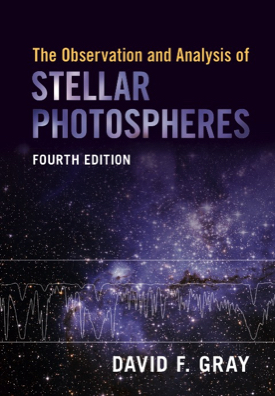The Observation and Analysis of Stellar Photospheres

The fourth edition has now been published. It is a significant improvement and update over the third edition, while still following the tried and true basic outline.
The electronic versions have all figures in full color! It is the version to get. Your lecture presentations will be easier and more straight forward with the electronic version. The paper version will be in black and white.
An astronomer's toolkit for understanding stellar spectra - that's this book. Starting with the basics, only minimal astronomical background is needed. Real stellar spectra - how we get them, what they look like, and how we extract information from them - is the focus. Spectroscopic tools, light detectors, radiation transfer are covered in the first few chapters. Next, the basics of continuous absorption sets the stage for building model photospheres, and with these we compute theoretical energy distributions that are compared to those of real stars. On to spectral lines: the line absorption coefficient, how to observe spectral lines, and information contained in them. Chapters 14-16 turn to using our tools to find radii, temperatures, surface gravities, and chemical composition of stars. Velocity fields within stellar photospheres and the rotation of stars comprise the final two chapters. Extensive referencing is given, especially in later chapters. Oriented toward first-year graduate students, researchers, and others curious about stars.
The book has 513 pages with these chapters:
Chapter 1: Background
Chapter 2: Fourier Transforms
Chapter 3: Spectroscopic Tools
Chapter 4: Light Detectors
Chapter 5: Radiation Terms and Definitions
Chapter 6: The Black Body and its Radiation
Chapter 7: Energy Transport in Stellar Photospheres
Chapter 8: The Continuous Absorption Coefficient
Chapter 9: The Model Photosphere
Chapter 10: Analysis of Stellar Continua
Chapter 11: The Line Absorption Coefficient
Chapter 12: The Measurement of Spectral Lines
Chapter 13: The Behavior of Spectral Lines
Chapter 14: The Measurement of Stellar Radii and Temperatures
Chapter 15: The Measurment of Surface Gravity
Chapter 16: The Measurement of Chemical Composition
Chapter 17: Velocity Fields in Stellar Photospheres
Chapter 18: Stellar Rotation
The book is suitable for advanced undergrads, graduate students, and researchers. There are many references to published papers, especially in the last four chapters. Useful numbers and examples are given throughout.
Preface to the Fourth Edition
Welcome again in this fourth edition to the wonderful world of stars and stellar spectroscopy. As you work your way through this material, you will gain insight into how stars behave and how we deduce their physical characteristics. If you are not careful, you will soon find yourself becoming emotionally attached to stars. And why not? There are many interesting subdisciplines in modern astronomy, but when we gaze into the dark night sky, it is the panorama of stars that makes our hearts beat faster.
Twinkle, twinkle on, oh bright little star,
we see your light travelling from oh so far.
The light you send us we work to decode,
analyzed and studied in spectroscopic mode.
Your light spread out in a glorious rainbow,
reveals your nature in a wonderful light show.
From continuum on through each spectral line,
send us your secrets about how you do shine.
As we learn more about just what you are,
you're ever more awesome, oh bright little star.
Twinkle, twinkle on in the dark still night;
inspire and teach us with your little light.
My heartfelt thanks to the friends and colleagues who have helped, guided, and encouraged me over the years.
You will notice the quaint watermark, "from David F. Gray Stellar Photospheres," on many of the figures. Should you choose to use figures from the book in talks, lectures, or web sites, this watermark will help you remember where the figures came from.
May your journey to understand stars be pleasant and fulfilling.
Here is the link to purchase in Canadian Dollars: https://www.ebooks.com/en-ca/ebooks/book_display.asp?IID=210397905
Or in US dollars: https://www.cambridge.org/highereducation/ and type Stellar Photospheres in the search box.